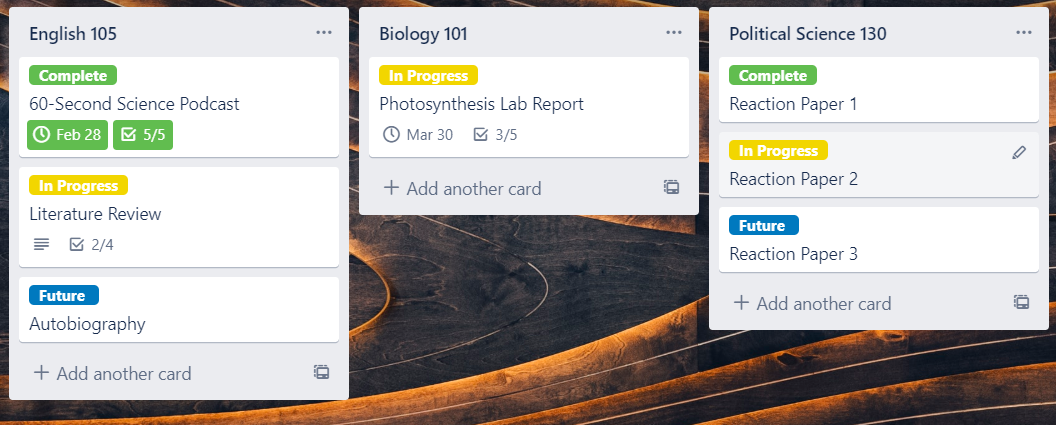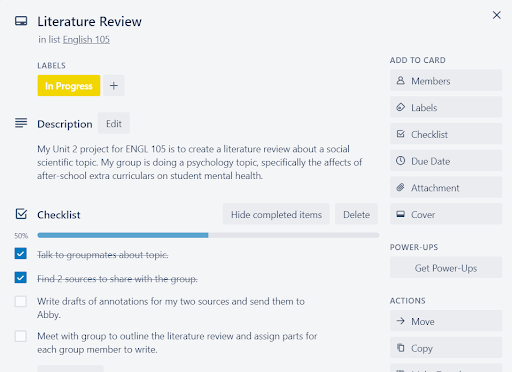Using Trello to Stay Organized in a Virtual World
By a UNC dissertation writer and Writing Center coach
What a spring. As new developments surrounding COVID-19 are announced on what seems like a daily basis, getting back to coursework remotely is a daunting and extraordinary task for all of us. One of the biggest difficulties posed by a switch to virtual learning is the loss of routine, which can severely impact our ability to stay organized and keep ourselves accountable for the many projects we have going on. I’ve found that losing my routine has been made even more challenging when school work has to compete with relocation, healthcare, isolation, changes in employment, and innumerable other significant life changes many of us are experiencing in this moment. How are you going to balance all of these tasks to make sure you budget your time wisely, prioritize effectively, and remember to do everything?
Trello: A tool for collaborative and group work
In this blog post, I want to introduce you to a tool I’ve used for exactly this: Trello. Trello is a tool designed to allow groups of people to collaborate on projects. The basic idea is that a team of people all sign up at Trello.com and create a shared workspace, called a “board,” where they can create reminders, checklists, and project notes and communicate with one another in an online collaborative space. After the board has been created, it will keep track of deadlines and notes, and you can even access the collaborative space using a mobile app.
We’ve used Trello here at the Writing Center to help coaches collaborate on some of the projects we work on when we don’t have appointments, like working together on resource development and social media outreach. One of the reasons Trello works so well for us is that it allows us to keep everything in a centralized place while still enabling individual coaches to maintain ownership over their own projects. Our shared Trello board contains all of our projects, so we can quickly send a note to a collaborator or invite someone else to offer us feedback on a project draft. However, it’s also easy to focus on your own projects and use Trello on a daily basis as a way to keep notes for yourself and manage your own priorities.
Creating a personal Trello board to organize my complicated life
After getting the hang of Trello as part of a group, I realized that it would be a great tool for me to use on my own. I have a ton of tasks to remember to do on a daily basis, and it takes a lot of mental energy just to keep track of all those tasks, let alone actually do them! As a sort of experiment for myself, I created a Trello board to organize and prioritize all those tasks. I have separate columns for my research work, teaching, data consultant work, and all the random things that pop up, like fellowship applications, conference proposals, doing my taxes, scheduling doctor’s appointments, or whatever. Recently, I’ve added things like going to the grocery store, getting/sending packages and mail, and other kinds of out-of-the-house tasks to my Trello so that, as much as possible, I can take care of several items on my list during a single outing, which has proven useful and effective as part of social distancing.
What a sample Trello board for coursework might look like

Once I made my board and columns, I populated each column with the specific tasks I needed to do. It’s kind of like putting sticky notes on a whiteboard, except your whiteboard can move around with you and you can rewrite what you put on your sticky notes! There’s a separate “card” (the name for the Trello feature where you track progress on individual projects) for all of the individual tasks I need to accomplish. When I get a new manuscript to review for my side job, I create a new card for it. When I figure out what part of my dissertation I’d like to write next, I create a card for that. When I know I have papers coming in and I’ll need to find time to grade them… card.
What I realized from my Trello board is just how much mental effort it had been taking to remember all of these different things! By creating a card for all the things I need to accomplish, I effectively give myself permission to forget about it. Trello has a record for me, and whenever I have time to sit down and work, I can look at my Trello board and get an instant reminder about all the things on my plate. I use labels to color-code all of my cards according to their priority, and I can even add deadline reminders to a card so it pings me on a certain date.
An example “card” for an English 105 literature review group project

It took a couple hours of investment to create my board at the beginning, but now that it’s created, I bet I save at least that initial investment of time every week by no longer having to sit and think about what I should be working on. And honestly, I can’t overstate how great it feels not to be anxious about having forgotten something. I’m just as busy as I’ve ever been, but now I can see at a glance what needs to be done by when. Things don’t sneak up on me anymore, and I can actually focus on whatever I’m working on because I don’t need to expend mental energy to keep all my other projects in my brain out of fear of forgetting them.
Trello as a tool for writing
In addition to its ability to help me organize and remember things, I’ve found that Trello is particularly useful as a tool for writing. Writing, especially for long projects, is a process with many steps. At some point, you’ll need to pick a topic, learn about it, plan the paper, write a draft (probably just a few pages at a time), review the draft, revise it, and turn it in. That whole project is probably daunting to look at as a whole, but those smaller tasks that make it up are much more approachable. Just think – you probably wouldn’t bat an eye at a class assignment that asked you to write a paragraph. Well, that 30-page research paper or 100-page honor’s thesis is just a big ol’ pile of paragraphs! Thinking about big projects like this is a great way to avoid anxiety and procrastination, and Trello’s whole layout is incredibly helpful for breaking down big projects into their component tasks.
That’s how Trello works for me
I mainly use Trello to remind me about the projects on my plate and break large projects down into smaller pieces. However, it’s a flexible tool, and someone else might find some of its other features even more attractive, like the mobile app or the ability to store links to Google Docs right in project cards. In the future, I plan to invite friends, groupmates, and writing partners to see my board to help keep me accountable and celebrate all of the good work I’m doing. If you’re like me, academic work can be tiring and lonely even when you’re not isolated or quarantined. Maybe Trello can help us all feel a bit less alone during this strange time.
This blog showcases the perspectives of UNC Chapel Hill community members learning and writing online. If you want to talk to a Writing and Learning Center coach about implementing strategies described in the blog, make an appointment with a writing coach or an academic coach today. Have an idea for a blog post about how you are learning and writing remotely? Contact us here.

